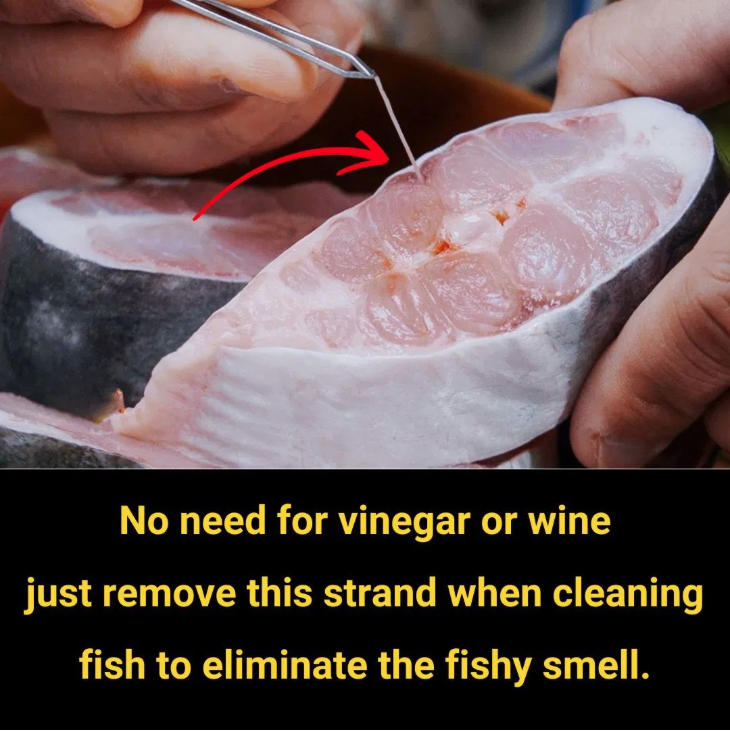When it comes to preparing fish, dealing with its distinct fishy smell is often one of the biggest challenges for home cooks. Whether you’re planning to grill, fry, or steam fish, that lingering odor can be off-putting and overpower the natural flavors of the dish. Many people instinctively turn to vinegar, lemon juice, or even alcohol to neutralize the smell. While these methods can be effective, they often alter the fish’s natural taste, leaving an unwanted aftertaste. However, there’s a lesser-known trick that requires no additional ingredients and works remarkably well—removing the thin white tendon running along the fish’s spine. This simple step can drastically reduce the fishy smell without impacting its flavor or texture.
Understanding the Source of the Fishy Smell
Fish naturally contain a compound called trimethylamine oxide (TMAO). After the fish is caught, TMAO begins to break down into trimethylamine (TMA), which is responsible for the characteristic fishy odor. While rinsing fish with vinegar or soaking it in alcohol can help neutralize TMA, these techniques sometimes leave behind their own flavors. However, one major but often ignored contributor to the odor is the white tendon located along the spine of certain fish, especially carp. Removing this tendon can dramatically reduce the smell without requiring any chemical agents or affecting the fish’s natural taste.
Locating the White Tendon
After gutting and cleaning your fish, place it flat on a clean cutting board. Using a sharp knife, make a shallow incision about one centimeter behind the fish’s head. Look carefully along the spine, and you’ll notice a thin, white, thread-like tendon running parallel to the backbone. This tendon is often overlooked during the cleaning process, but it holds a significant amount of the compounds responsible for the fishy smell.
How to Remove the White Tendon
To remove the tendon, gently grip it using your fingers, tweezers, or a small pair of pliers. Slowly pull it out in one steady motion, being careful not to break it. If the tendon snaps, you’ll need to start again from the incision point to ensure it’s fully extracted. Once you’ve removed the tendon from one side, repeat the same process on the other side of the fish.
While this step might seem minor, its impact is significant. Removing the tendon reduces the odor at the source rather than masking it with acidic or alcoholic ingredients. This means you’ll enjoy a cleaner, fresher fish flavor in every bite.
Why This Method Outshines Vinegar and Alcohol
Using vinegar or alcohol to soak fish is a common practice for reducing odor, but these solutions have their downsides. Vinegar can leave a slightly sour taste, and alcohol may not fully evaporate during cooking, leaving traces of its flavor in the dish.
In contrast, removing the white tendon directly targets the source of the smell. It’s an entirely natural method that doesn’t introduce any new flavors or compromise the texture of the fish. Plus, it’s cost-effective and doesn’t require any special tools—just a steady hand and a little attention to detail.
Additional Tips for Preparing Odor-Free Fish
While removing the tendon is a game-changing trick, there are a few other steps you can follow to ensure your fish is as fresh and odor-free as possible:
- Choose Fresh Fish: Always buy fish from a reputable supplier and, if possible, cook it the same day you purchase it. Fresh fish has less odor.
- Clean Thoroughly: Rinse the fish under cold running water to remove blood, scales, and any internal residue.
- Use Salt Water Soaks: Briefly soaking the fish in lightly salted water can help reduce odor further without altering the flavor.
- Pat Dry Before Cooking: Excess moisture can intensify the smell during cooking, so always pat your fish dry with paper towels.
By combining these tips with tendon removal, you’ll be able to prepare fish that’s fresh, flavorful, and free from overpowering odors.
A Versatile Method for Every Fish Recipe
This tendon-removal trick works well across different fish recipes, whether you’re pan-searing filets, grilling whole fish, or making a fish stew. Since it doesn’t alter the flavor, you’ll have complete control over seasoning and marinades. Picture a beautifully seared carp filet, seasoned to perfection, with no lingering odor affecting its delicate flavor—that’s the result you can expect from this technique.
Why Every Home Cook Should Know This Trick
For many home cooks, dealing with fish odor has always meant relying on acidic solutions or strong-smelling liquids. But removing the white tendon along the fish’s spine offers a smarter, cleaner approach. It’s quick, effective, and doesn’t require any special skills or expensive ingredients.
Best of all, this method isn’t limited to seasoned chefs—it’s a simple step anyone can master with just a little care and patience. Once you try it, you’ll realize just how much difference this tiny tendon makes in the final dish.
Final Thoughts
Eliminating fish odor doesn’t need to involve overpowering additives or complicated tricks. By focusing on the root cause and removing the white tendon along the fish’s spine, you can achieve a cleaner, fresher taste without compromising flavor or texture. This simple yet highly effective technique is something every home cook should have in their toolkit.
The next time you prepare fish, take a moment to locate and remove the tendon. It’s a small step with big results, ensuring your dishes are free from unwanted odors and full of clean, natural flavor. With this trick in hand, you’ll never look at fish preparation the same way again. Try it once, and you’ll wonder why this secret isn’t more widely known!



